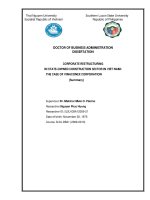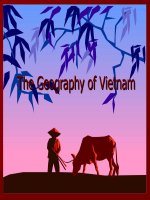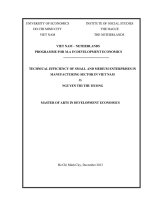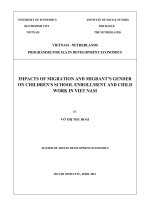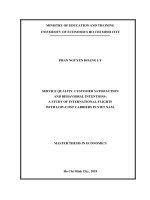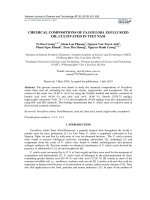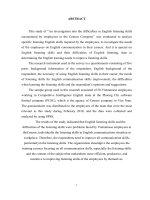Chemical compositions of Passiflora edulis seed oil cultivated in Viet Nam
Bạn đang xem bản rút gọn của tài liệu. Xem và tải ngay bản đầy đủ của tài liệu tại đây (502.1 KB, 8 trang )
Vietnam Journal of Science and Technology 57 (5) (2019) 551-558
doi:10.15625/2525-2518/57/5/13801
CHEMICAL COMPOSITIONS OF PASSIFLORA EDULIS SEED
OIL CULTIVATED IN VIET NAM
To Dao Cuong1, 2, *, Doan Lan Phuong1, Nguyen Van Tuyen Anh1,
Pham Ngoc Khanh1, Tran Thu Huong1, Nguyen Manh Cuong1, 2, *
1
Institute of Natural Products Chemistry, Vietnam Academy of Science and Technology (VAST),
18 Hoang Quoc Viet, Cau Giay, Ha Noi
2
Graduate University of Science and Technology, Vietnam Academy of Science and Technology
(VAST), 18 Hoang Quoc Viet, Cau Giay, Ha Noi
*
Email: ,
Received: 3 May 2019; Accepted for publication: 1 July 2019
Abstract. The present research was aimed to study the chemical compositions of Passiflora
edulis Sims seed oil, including the fatty acid, sterols, triglycerides, and tocopherols. The oil
content of the seeds was 24.88 % (w/w) by using the Soxhlet method and mainly consisted of
linoleic acid (-6, 66.94 %) and oleic acid (-9, 18.86 %). Sterols (2935.35 mg/kg),
triglycerides (monomer TAG, 74.11 %) and tocopherols (18.04 mg/kg) were also determined by
using IOC and ISO methods. The findings demonstrate that P. edulis seed oil could be used in
the food and cosmetic industries.
Keywords: Passiflora edulis, Passifloraceae, seed oil, fatty acid, sterol, triglyceride, tocopherol.
Classification numbers: 1.3.1, 1.4.1.
1. INTRODUCTION
Passiflora edulis Sims (Passifloraceae), a popular tropical fruit throughout the world is
usually used for juice production [1]. In Viet Nam, P. edulis is popularly cultivated in Tay
Nguyen, Nghe An and Son La with areas of over ten thousand hectares. The P. edulis extracts
were found to possess biological activities, including antioxidant [2], antifungal [3] and
compounds from the seeds of P. edulis were found to inhibit melanogenesis and promote
collagen synthesis [4]. Previous studies on chemical constituents of P. edulis seeds showed the
presence of stilbenoids [4, 5], oil and tocopherols [6].
P. edulis seeds accounted for 6-12 % of fruit weight and they were used for the treatment of
constipation and hemorrhoids [7]. P. edulis seed oil belonged to the polyunsaturated oil class,
containing greater linoleic acid (65-70 %) and oleic acid (15-20 %) [8] similar to most of the
commercial edible oils, i.e., sunflower, soybean, and corn oil [9]. Linoleic acid and oleic acid are
important in human food because of its prevention of certain cardiovascular diseases [10]. They
also find application in the food, perfume and aroma industries [11]. In spite of the number of
To Dao Cuong et al.
studies that have been performed [7, 12], there has been no investigation of chemical compositions
and antioxidant activity of P. edulis seed oil cultivated in Viet Nam. Therefore, this paper
describes the fatty acid, sterols, triglycerides and tocopherols profiles from P. edulis seed oil.
2. MATERIALS AND METHODS
2.1. Plant materials
The seeds of Passiflora edulis Sims were provided by Nafoods Group JSC (Nghe An
Province, North Viet Nam) in 2016 and identified by botanist Dr. Nguyen Quoc Binh, Viet Nam
National Museum of Nature, VAST, Ha Noi, Viet Nam. A voucher specimen (C-573) was
deposited in the Herbarium of the Institute of Natural Products Chemistry, VAST.
2.2. Oil extraction
The oil was obtained from P. edulis seeds by Soxhlet extraction according to the
International Organization for Standardization (ISO) method [13]. Briefly, 10 g of dry seeds was
grinded in a ball mill and extracted with 200 mL of hexane by the Soxhlet apparatus at 60 -70 ºC
for 6 h. After extraction, the solvent was removed to obtain 2.488 g of oil (24.88 %).
2.3. Analysis of fatty acid, sterol, triacylglycerol and tocopherol profiles
2.3.1. Fatty acid composition
Fatty acid was determined by gas chromatography followed by the ISO standard method
with some modifications [14].
2.3.2. Sterol profile
Sterol was determined according to the International Olive Oil Council (IOOC) method
[15]. To identify the individual peaks of sterols, the determination of relative ����������������������������������������������������������������������������������������������������������������������������������������������������������������������������������������������������������������������������������������������������������������������������������������������������������������������������������������������������������������������������������������������������������������������������������������������������������������������������������������������������������������������������������������������������������������������������������������������������������������������������������������������������������������������������������������������������������������������������������������������������������������������������������������������������������������������������������������������������������������������������������������������������������������������������������������������������������������������������������������������������������������������������������������������������������������������������������������������������������������������������������������������������������������������������������������������������������������������������������������������������������������������������������������������������������������������������������������������������������������������������������������������������������������������������������������������������������������������������������������������������������������������������������������������������������������������������������������������������������������������������������������������������������������������������������������������������������������������������������������������������������������������������������������������������������������������������������������������������������������������������������������������������������������������������������������������������������������������������������������������������������������������������������������������������������������������������������������������������������������������������������������������������������������������������������������������������������������������������������������������������������������������������������������������������������������������������������������������������������������������������������������������������������������������������������������������������������������������������������������������������������������������������������������������������������������������������������������������������������������������������������������������������������������������������������������������������������������������������������������������������������������������������������������������������������������������������������������������������������������������������������������������������������������������������������������������������������������������������������������������������������������������������������������������������������������������������������������������������������������������������������������������������������������������������������������������������������������������������������������������������������������������������������������������������������������������������������������������������������������������������������������������������������������������������������������������������������������������������������������������������������������������������������������������������������������������������������������������������������������������������������������������������������������������������������������������������������������������������������������������������������������������������������������������������������������������������������������������������������������������������������������������������������������������������������������������������������������������������������������������������������������������������������������������������������������������������������������������������������������������������������������������������������������������������������������������������������������������������������������������������������������lue of P. edulis seed oil
was found to be 125.77. P. edulis seed oil shows a low saponification value (174.96). The
refractive index (1.472) of the oil is in the range with the values obtained for some conventional
oils such as soybean oil (1.466-1.470) [22] and is similar to that of P. edulis Sims (1.4731) in
China [19]. This property suggests that oil can be used in studies relating to optics [23].
3.3. Sterol composition
Total phytosterols are present in amounts from 0.1 to 0.3% of total oil. These values are in
agreement with those already described for walnuts and are in the same range of those found in
olive, peanut, and hazelnut oils but lower than those found in the majority of other oils [24]. The
identified compounds are listed in Table 3. Results showed that the phytosterols (2935.35 mg/kg)
of P. edulis seed oil were higher than that of P. edulis Sims (2090 mg/kg) in Kenya [6]. Several
typical sterols were predominant in the studied sample, including campesterol, stigmasterol, βsitosterol, ∆5,23-stigmastadienol, and ∆5-avenasterol (Table 3). β-sitosterol (1112.68 mg/kg), the
major sterol in P. edulis seed oil was also higher than that of P. edulis Sims (870.2 mg/kg) in
Kenya [6]. β-sitosterol was reported to have anti-hypercholesterolemic, anti-inflammatory, antibacterial, anti-fungal, anti-hyperlipoproteinemic activities and inhibited carcinogenesis [25].
The contents of campesterol (353.49 mg/kg), stigmasterol (910.70 mg/kg) and ∆5avenasterol (146.53 mg/kg) in the seed oil of P. edulis were also higher than that of P. edulis
Sims in Kenya (282 mg/kg for campesterol, 871 mg/kg for stigmasterol and 69 mg/kg for ∆ 5avenasterol) [6].
554
Chemical compositions of Passiflora edulis seed oil cultivated in Viet Nam
Table 3. Sterol compositions (%) of P. edulis seed oil.
No
Retention time (min)
Sterol
Content (mg/kg)
1
36.257
Cholesterol
8.18
2
36.727
Cholestanol
-
3
38.277
Brassicasterol
72.76
4
41.240
24-Methylencholesterol
3.65
5
41.567
Campesterol
353.49
6
41.937
Campestanol
53.55
7
43.023
Stigmasterol
910.70
7
8
44.133
∆ -Campesterol
22.37
9
45.050
∆5,23-Stigmastadienol
12.95
10
45.480
Clerosterol
11.54
11
45.907
-Sitosterol
1112.68
12
46.213
Sitostanol
57.39
13
14
46.573
47.573
5
∆ -Avenasterol
∆
5,24
-Stigmastadienol
7
146.53
17.09
15
48.290
∆ -Stigmastenol
75.26
16
48.950
∆7-Avenasterol
77.20
Total
2935.35
(-): not detected.
3.4. Triglyceride (TG) composition
The qualitative and quantitative of TG contents can be used as markers for the detection of
oil adulteration [26]. The percentage content of TG in P. edulis seed oil is shown in Table 4. The
most frequent TG is monomer triacylglycerol (TAG, 74.31 %), diglyceride (11.49 %) and free
fatty acids (FFA, 8.85 %). These results suggested that P. edulis seed oil contains a high amount
of monomer TAG (74.31 %).
Table 4. Triglyceride compositions (%) of oil extract from P. edulis seed.
No
Retention time (min)
Triglyceride type
Values (%)
1
24.550
Monomer TAG
74.31
2
25.367
Diglyceride
11.49
3
26.717
Monoglyceride
1.47
4
28.867
FFA
8.85
5
29.533
Glycerin
0.85
Other
3.03
Total
100
555
To Dao Cuong et al.
3.5. Tocopherol composition of P. edulis seed oil
A further important criterion for the assessment of seed oil was the content of tocopherol.
The major tocopherols in the P. edulis seed oil were found to be -T (5.55 mg/kg) and -T (9.37
mg/kg) (Table 5). The total tocopherol (18.04 mg/kg) in P. edulis oil was lower than that of P.
edulis Sims (465 mg/kg) in China [19] and P. edulis f. flavicarpa (499.30 mg/kg) in Brazil [20].
The -T (9.37 mg/kg) in P. edulis oil was higher than that of sunflower (9.2 mg/kg), canola (6.1
mg/kg) oils [27] and lower than that of P. edulis Sims (243 mg/kg) in China [18] and P. edulis
f. flavicarpa (278.70 mg/kg) in Brazil [20].
Table 5. Tocopherol compositions of P. edulis seed oil.
No Retention time (min) Compounds
Values (mg/kg)
1
12.532
α-T
0.34
2
16.849
α-T3
0.29
3
24.605
β-T
2.49
4
26.163
γ-T
5.55
5
39.793
δ-T
9.37
Total tocopherols
18.04
The quantity and nature of tocopherols naturally present in such unsaturated oils is of
crucial importance regarding their oxidative stability. Tocopherols are natural antioxidants and
depending on their nature, they can differ in their antioxidant capacity. Indeed, -tocopherols and
-tocopherols are believed to be better antioxidant than -and -tocopherols [28]. Therefore, one
can expect P. edulis seed oil to be protected against oxidation because of high amounts of -and
-tocopherols.
4. CONCLUSION
In this work, the fatty acid, sterol, triglyceride and tocopherol compositions from the P.
edulis seed oil cultivated in Viet Nam were investigated for the first time. The P. edulis seeds
contained a high amount of oil (24.88 %, w/w). The major monounsaturated and saturated fatty
acids were linoleic acid (66.94 %) and oleic acid (18.86 %). Steroids were predominant in the P.
edulis seed oil, including several typical sterols such as campesterol, stigmasterol, β-sitosterol,
∆5,23-stigmastadienol, and ∆5-avenasterol. β-sitosterol was the major sterol (1112.68 mg/kg) in P.
edulis seed oil. The most frequent TG is monomer TAG (74.31 %), diglyceride (11.49 %), and
free fatty acids (FFA, 8.85 %). The total of tocopherols in P. edulis seed oil was 18.04 mg/kg
and the major tocopherols were found to be -T (5.55 mg/kg) and -T (9.37 mg/kg).
Acknowledgement: This research is funded by the Vietnam Academy of Science and Technology (VAST)
under grant no. VAST.CTG.03/17-18. The authors wish to thank Nafoods Group Join Stock Company,
Nghe An province for the supporting materials.
556
Chemical compositions of Passiflora edulis seed oil cultivated in Viet Nam
REFERENCES
1.
2.
3.
4.
5.
6.
7.
8.
9.
10.
11.
12.
13.
14.
15.
16.
Fraife Filho G. A., Leite J. B. V, Ramos J. V. - Passion fruit. Available from:
(Accessed in Apr 25, 2012).
Lourith N., Kanlayavattanakul, M. – Antioxidant activities and Phenolics of Passiflora
edulis seed recovered from juice production residue, J. Oleo Sci. 64 (2013) 235–240.
Pelegrini P. B., Noronha E. F., Muniz M. A., Vasconcelos I. M., Chiarello M. D., Oliveira
J. T., Franco O.L. - An antifungal peptide from passion fruit (Passiflora edulis) seed with
similarities to 2S albumin proteins, Biochim. Biophys. Acta 1764 (2006) 1141–1146.
Matsui Y., Sugiyama K., Kamei M., Takahashi T., Suzuki T., Katagata Y., Ito T. - Extract
of Passion Fruit (Passiflora edulis) Seed Containing High Amounts of Piceatannol
Inhibits Melanogenesis and Promotes Collagen Synthesis, J. Agric. Food Chem. 58 (2010)
11112–11118.
Sano, S., Sugiyama, K., Ito, T., Katano, Y., Ishihata, A. - Identification of the strong
vasorelaxing substance scirpusin B, a dimer of piceatannol, from passion fruit (Passiflora
edulis) seed, J. Agric. Food Chem. 59 (2011) 6209–6213.
Piombo G., Barouh N., Barea B., Boulanger R., Brat P., Pina M., Villeneuve P. Characterization of the seed oils from kiwi (Actinidia chinensis), passion fruit (Passiflora
eulis) and guava (Psidium guajava), Ocl Ol Corps Gras Li. 13 (2006) 195–199.
Chau, C., Huang, Y. - Characterization of passion fruit seed fibers - a potential fiber
source, Food Chem. 85 (2004) 189–194.
Regis S. A., de Resende E. D., Antoniassi R. - Oil quality of passion fruit seed subjected
to a pulp-waste purification process, Ciência Rural 45 (2015) 977–984.
Dubois V., Breton S., Linder M., Fanni J., Parmentier M. - Fatty acid profiles of 80
vegetable oils with regard to their nutritional potential, Eur. J. Lipid Sci. Technol. 109
(2007) 710–732.
Gupta S., Shrivastava S. K., Shrivastava M. - Fatty acid composition of new hybrid
varieties of minor millets seed, IIOAB J. 5 (2014) 15–18.
Lopez A S. - Lipids from the seed of passion fruit (Passiflora edulis), Rev. Theobroma 10
(1980) 47–50.
Liu S. C., Yang F., Li J. L. Zhang C. H., Ji H. W., Hong P. J. - Physical and chemical
analysis of Passiflora seed and seed oil from China, Int. J. Food Sci. Nutr. 59 (2008) 706–
715.
International Organization for Standardization. Oil seed - Determination of oil content,
ISO Geneva, Switzerland, Standard No. 659, 1988.
International Organization for Standardization. Animal and vegetable fats and oilspreparation of methyl esters of fatty acids, ISO, Geneva, Switzerland, Standard No. 5509,
1988.
International Olive Council. Determination of the composition and content of sterols by
capillary-column gas chromatography, Spain; Madrid, COI/T, 20/Doc. No. 10 Rev. 2001.
International Olive Council. Determination of the composition and content of sterols and
triterpene dialcohols by capillary column gas chromatography, Spain; Madrid, COI/T,
20/Doc. No. 30/Rev. 2013.
557
To Dao Cuong et al.
17. International Olive Council. Determination of the difference between actual and
theoretical content of triacylglycerols with ECN 42, International Olive Council,
COI/T.20/Doc. no. 20 /Rev. 2, 2008.
18. International Organization for Standardization. Animal and vegetable fats and oilsDetermination of tocopherol and tocotrienol contents by high-performance liquid
chromatography, ISO, Geneva, Switzerland, Standard No. 9936, 2006.
19. Liu S. C., Yang F., Li J. L., Zhang C. H., Ji, H. W., Hong P. Z. - Physical and chemical
analysis of Passiflora seeds and seed oil from China, Int. J. Food Sci. Nutr. 59 (2008)
706–715.
20. Malacrida C. R., Jorge N. - Yellow Passion Fruit Seed Oil (Passiflora edulis f.
flavicarpa): Physical and Chemical Characteristics, Braz. Arch. Biol. Technol. 55 (2012)
127–134.
21. Nyanzi S., Carstensen B., Schwack W. - A comparative study of fatty acid profiles of
Passiflora seed oils from Uganda, J. Am. Oil. Chem. Soc. 82 (2005) 41–44.
22. Codex Alimentarius Commission. Codex-Stan 210: codex standard for named vegetable
oils. Rome, 2008.
23. Ju Y., Chen T. - High-purity γ-linolenic acid from borage oil fatty acids, J. Am. Oil.
Chem. Soc. 79 (2002) 29–32.
24. Kamm W., Dionisi F., Hischenhuber C., Engel K. - Authenticity assessment of fats and
oils, Food ReV. Int. 17 (2001) 249–290.
25. Yasukawa K., Takido M., Matsumoto T., Takeuchi M., Nakagawa S. - Sterol and
triterpene derivatives from plants inhibit the effects of a tumor promoter, and sitosterol
and betulinic acid inhibit tumor formation in mouse skin two-stage carcinogenesis,
Oncology. 41 (1991) 72–78.
26. Harrabi S., Boukh S., Kallel H., Mayer P. M. - An electrospray-ionization mass
spectrometry analysis of triacylglycerol in developing corn kernels, Can. J. Anal. Sci.
Spectr. 53 (2008) 22–27.
27. Tuberoso C. I. G., Kowalczyk A., Sarritzu E., Cabras P. - Determination of antioxidant
compounds and antioxidant activity in commercial oilseed for food use, Food Chem. 103
(2007) 1494–501.
28. Rossignol-Castera A., Bosque F. - Nouvelle Approche des Antioxydants, OCL 1 (1994)
10–15.
558
